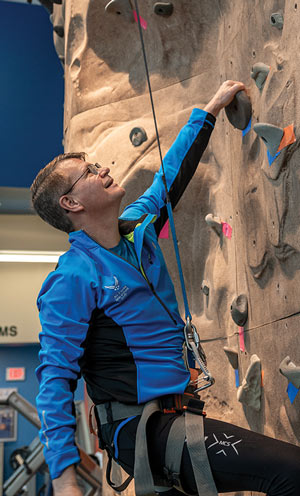
Ignite | Spring 2022
What’s in your backpack?
The patient has a broken arm. You are miles from the nearest medical facility and all you have with you is a small bag with a piece of gauze and some ACE bandage tape. What do you do?
That’s the sort of scenario first-year College of Medicine student Justine Busby encountered in an advanced wilderness medicine course last fall.
“The training focused on situational awareness,” she recalls. “One of the scenarios was that two people fell as they were roping down a small cliff. There was a snake that a lot of people in the training didn't notice at first, and then everything went awry. The instructor said, ‘Okay, everyone got bitten and now you're all dead!’
“You have to pay attention to your surroundings when you’re out in a wilderness situation. There may be something urgent in the environment that needs to be addressed before the medical emergency.”
Busby discovered the training course through her involvement in the Wilderness Medicine Interest Group — also known as WildMed — at NEOMED. She now serves as the group’s vice president.
THERE’S NOTHING LIKE THIS
WildMed was started by second-year medicine students Nicole Price (club president) and Christopher Roscoe in March 2021. The group is a chapter of the Wilderness Medical Society (WMS), which includes 42 student interest groups at universities across the United States and Canada.
Just one year in, the NEOMED group already has more than 100 members. “It grew really fast,” says Price. “When we started, we said we would be happy if we got 10 people.”
The group brings low- or no-cost learning opportunities to students by collaborating with other organizations. For instance, at virtual WildMed Wednesdays, produced by the WMS group at Yale University, participants learn about topics from treating snake venom to wilderness dentistry and neurology in the wild.
 Speakers from the NEOMED community have included President John Langell, M.D. (photo, left at a “Climb with the President” event at NEOMED) and Savannah Chavez, M.D., an emergency medicine resident at Summa Health in Akron, who has conducted a series of mini lectures on wilderness medicine topics such as “When Plants and Animals Attack.” A talk on space medicine by Philip C. Stepaniak, M.D. (’83) was especially popular.
Speakers from the NEOMED community have included President John Langell, M.D. (photo, left at a “Climb with the President” event at NEOMED) and Savannah Chavez, M.D., an emergency medicine resident at Summa Health in Akron, who has conducted a series of mini lectures on wilderness medicine topics such as “When Plants and Animals Attack.” A talk on space medicine by Philip C. Stepaniak, M.D. (’83) was especially popular.
Through Ohio Search and Rescue, a group based in Columbus, Ohio, students have access to trainings twice a month to learn skills like land navigation, wilderness first aid and search tactics. They also can volunteer to assist on search-and-rescue missions in Ohio, West Virginia and parts of Pennsylvania. Some members, including Price and Roscoe, are participating in a program to become a Fellow of the Academy of Wilderness Medicine, completing requirements via the Wilderness Medical Society.
And through a collaboration with True North Wilderness Survival School in Pittsburgh, 15 NEOMED students become certified in wilderness first aid. “It was pretty cool,” says Price. “The instructor would give us a scenario and then ask us what we’d do next. Whatever we had in our backpack was what we could use. The point was to figure out how to make do with what you have.”
WildMed also partnered with Sequoia Wellness, the fitness center on campus, for the January 2022 re-opening of the Michelle and Rick Mulhern Rock Wall, which had closed at the beginning of the COVID-19 pandemic.
MAKE DO WITH WHAT YOU HAVE
Founding member Roscoe, who serves as WildMed treasurer, finds parallels between wilderness medicine and his 11 years of experience in the military.
“As a Navy corpsman, we ended up operating mostly in austere environments. As a Navy doctor, it will be the same deal: I'll be operating in austere environments, from desert to jungle to mountainous regions,” he says. “I think it's really good to know how to be prepared for that and how to be prepared for some weird things, like what do you do if you get stung by an unknown animal? Do you wait and see what happens? Or do you call in a $3 million helicopter to come pick somebody up and take them out?”
Busby, who left active duty as a captain in the U.S. Army before beginning her studies at NEOMED, concurs. “What I learned from being in the Army is that you make do with what you have,” she says. “A lot of times there are minimal resources to get the mission done.”
THE TAMER SIDE OF WILDMED
Wilderness medicine isn’t always intense.
WildMed recently began partnering with the Portage (Ohio) County Park System to help teach wilderness preparedness to a lay audience. The “Wild Med Park” program will offer four sessions a year, based on wilderness first aid. Topics include what to pack for a hike and what to put in a first aid kit. The educational sessions will be followed by a student-led hike in the park system.
Price notes that WildMed students will be able to apply the skills they learn to their chosen field, even if it isn’t wilderness medicine. As someone considering emergency medicine, she says, “I'm not going to be trekking the mountains. People do that, but I would like to practice in the clinical setting,” she said. “This is a good way to combine both things that I love.”
